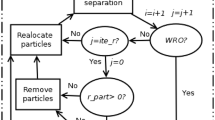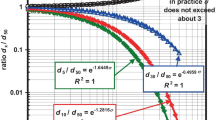Abstract
Computers have been taught to clone granular soil particles for discrete element method simulations to alleviate difficulties of using three-dimensional imaging techniques for scanning a large number of particles. In this process, computers analyze a few scanned particles to extract morphological characteristics of the target soil, which are used to clone as many particles as necessary. However, many natural granular soils contain a wide range of particle shapes mixing more than one type of morphological characteristics, causing difficulties in cloning. This research aims to address this challenge by integrating spherical harmonics with Gaussian mixture model, expectation–maximization, and Dirichlet process. Spherical harmonics coefficients are used to characterize morphological information of the granular soil. Gaussian mixture model is used to fit a function to the mixed morphological characteristics. The expectation–maximization and Dirichlet process are used to estimate the fitting parameters in Gaussian mixture model. Then, Gaussian mixture model is used to generate new spherical harmonics coefficients and then generate new particles. The effectiveness and accuracy of the proposed methodology are verified using a Griffin sand. Although this approach is developed for granular soils, the proposed technique can also be used to clone other particulate materials.














Similar content being viewed by others
References
Alshibli KA, Alsaleh MI (2004) Characterizing surface roughness and shape of sands using digital microscopy. J Comput Civ Eng 18:36–45. https://doi.org/10.1061/~ASCE!0887-3801~2004!18:1~36!
Alshibli KA, Cil MB (2018) Influence of particle morphology on the friction and dilatancy of sand. J Geotech Geoenviron Eng 144:04017118. https://doi.org/10.1061/(ASCE)GT.1943-5606.0001841
Altuhafi FN, Coop MR, Georgiannou VN (2016) Effect of particle shape on the mechanical properties of natural sands. J Geotech Geoenviron Eng 142:1–15. https://doi.org/10.1061/(ASCE)GT.1943-5606.0001569
Amendola C, Faugere JC, Sturmfels B (2016) Moment varieties of gaussian mixtures. J Algebr Stat 7:14–28. https://doi.org/10.18409/jas.v7i1.42
Anochie-Boateng JK, Komba JJ, Mvelase GM (2013) Three-dimensional laser scanning technique to quantify aggregate and ballast shape properties. Constr Build Mater 43:389–398. https://doi.org/10.1016/j.conbuildmat.2013.02.062
Aschenbrenner BC (1956) A new method of expressing particle sphericity. J Sediment Res 26:15–31. https://doi.org/10.1306/74D704A7-2B21-11D7-8648000102C1865D
Bareither CA, Edil TB, Benson CH, Mickelson DM (2008) Geological and physical factors affecting the friction angle of compacted sands. J Geotech Geoenviron Eng 134:1476–1489. https://doi.org/10.1061/(asce)1090-0241(2008)134:10(1476)
Biernacki C, Celeux G, Govaert G (2003) Choosing starting values for the EM algorithm for getting the highest likehood in multivariate Gaussian mixture models. Comput Stat Data Anal 41:561–575. https://doi.org/10.1016/S0167-9473(02)00163-9
Cavarretta I, O’Sullivan C, Coop MR (2010) The influence of particle characteristics on the behaviour of coarse grained soils. Geotechnique 60:413–423. https://doi.org/10.1680/geot.2010.60.6.413
Cho G-C, Dodds J, Santamarina JC (2006) Particle shape effects on packing density, stiffness, and strength: natural and crushed sands. J Geotech Geoenviron Eng 132:591–602. https://doi.org/10.1061/(asce)1090-0241(2006)132:5(591)
Cil MB, Alshibli KA, Kenesei P (2017) 3D experimental measurement of lattice strain and fracture behavior of sand particles using synchrotron X-ray diffraction and tomography. J Geotech Geoenvirom Eng 143:1–18. https://doi.org/10.1061/(ASCE)GT.1943-5606.0001737
Druckrey AM, Alshibli KA, Al-Raoush RI (2016) 3D characterization of sand particle-to-particle contact and morphology. Comput Geotech 74:26–35. https://doi.org/10.1016/j.compgeo.2015.12.014
Galindo-Torres SA, Muñoz JD, Alonso-Marroquín F (2010) Minkowski-Voronoi diagrams as a method to generate random packings of spheropolygons for the simulation of soils. Phys Rev E Stat Nonlinear Soft Matter Phys 82:1–12. https://doi.org/10.1103/PhysRevE.82.056713
Galindo-Torres SA, Pedroso DM, Muñoz JD, Alonso-Marroquín F (2010) Molecular dynamics simulations of complex-shaped particles using Voronoi-based spheropolyhedra. Phys Rev E. https://doi.org/10.1103/physreve.81.061303
Grigoriu M, Garboczi E, Kafali C (2006) Spherical harmonic-based random fields for aggregates used in concrete. Powder Technol 166:123–138. https://doi.org/10.1016/j.powtec.2006.03.026
Guida G, Viggiani GMB, Casini F (2009) Multi-scale morphological descriptors from the fractal analysis of particle contour. Acta Geotech. https://doi.org/10.1007/s11440-019-00772-3
Hayakawa Y, Oguchi T (2005) Evaluation of gravel sphericity and roundness based on surface-area measurement with a laser scanner. Comput Geosci 31:735–741. https://doi.org/10.1016/j.cageo.2005.01.004
Hryciw RD, Zheng J, Shetler K (2016) Particle roundness and sphericity from images of assemblies by chart estimates and computer methods. J Geotech Geoenviron Eng. https://doi.org/10.1061/(ASCE)GT.1943-5606.0001485
Jerves AX, Kawamoto RY, Andrade JE (2016) Effects of grain morphology on critical state: a computational analysis. Acta Geotech 11:493–503. https://doi.org/10.1007/s11440-015-0422-8
Kandasami R, Murthy T (2014) Effect of particle shape on the mechanical response of a granular ensemble. 3rd International symposium on geomechanics from micro to macro. Univ Cambridge, Cambridge, pp 1093–1098
Kim H, Haas CT, Rauch AF, Browne C (2002) Dimensional ratios for stone aggregates from three-dimensional laser scans. J Comput Civ Eng 16:175–183. https://doi.org/10.1061/(ASCE)0887-3801(2002)16:3(175)
Krumbein WC, Sloss LL (1951) Stratigraphy and sedimentation. W.H Freeman and Company, San Francisco
Kuo C-Y, Freeman R (2000) Imaging indices for quantification of shape, angularity, and surface texture of aggregates. Transp Res Rec J Transp Res Board 1721:57–65. https://doi.org/10.3141/1721-07
Lai Z, Chen Q (2019) Reconstructing granular particles from X-ray computed tomography using the TWS machine learning tool and the level set method. Acta Geotech 14:1–18. https://doi.org/10.1007/s11440-018-0759-x
Li C, Zheng J, Zhang Z et al (2020) Morphology-based indices and recommended sampling sizes for using image-based methods to quantify degradations of compacted aggregate materials. Constr Build Mater 230:116970. https://doi.org/10.1016/j.conbuildmat.2019.116970
Liu X, Garboczi EJ, Grigoriu M et al (2011) Spherical harmonic-based random fields based on real particle 3D data: improved numerical algorithm and quantitative comparison to real particles. Powder Technol 207:78–86. https://doi.org/10.1016/j.powtec.2010.10.012
Liu X, Yang J (2018) Shear wave velocity in sand: effect of grain shape. Géotechnique 68:742–748. https://doi.org/10.1680/jgeot.17.t.011
Melnykov V, Melnykov I (2012) Initializing the em algorithm in Gaussian mixture models with an unknown number of components. Comput Stat Data Anal 56:1381–1395. https://doi.org/10.1016/j.csda.2011.11.002
Mollon G, Zhao J (2012) Fourier–Voronoi-based generation of realistic samples for discrete modelling of granular materials. Granul Matter 14:621–638. https://doi.org/10.1007/s10035-012-0356-x
Mollon G, Zhao J (2013) Generating realistic 3D sand particles using Fourier descriptors. Granul Matter 15:95–108. https://doi.org/10.1007/s10035-012-0380-x
Mollon G, Zhao J (2014) 3D generation of realistic granular samples based on random fields theory and Fourier shape descriptors. Comput Methods Appl Mech Eng 279:46–65. https://doi.org/10.1016/j.cma.2014.06.022
Mora CF, Kwan AKH (2000) Sphericity, shape factor, and convexity measurement of coarse aggregate for concrete using digital image processing. Cem Concr Res 30:351–358. https://doi.org/10.1016/S0008-8846(99)00259-8
Müller C (2006) Spherical harmonics. Springer, Berlin
Nie Z, Liang Z, Wang X (2018) A three-dimensional particle roundness evaluation method. Granul Matter 20:1–11. https://doi.org/10.1007/s10035-018-0802-5
Nouguier-Lehon C, Cambou B, Vincens E (2003) Influence of particle shape and angularity on the behaviour of granular materials: a numerical analysis. Int J Numer Anal Methods Geomech 27:1207–1226. https://doi.org/10.1002/nag.314
Otsu N (1979) A threshold selection method from gray-level histograms. IEEE Trans Syst Man Cybern 9:62–66
Otsubo M, O’Sullivan C, Sim WW, Ibraim E (2015) Quantitative assessment of the influence of surface roughness on soil stiffness. Géotechnique 65:694–700. https://doi.org/10.1680/geot.14.T.028
Pernkopf F, Bouchaffra D (2005) Genetic-based EM algorithm for learning Gaussian mixture models. IEEE Trans Pattern Anal Mach Intell 27:1344–1348. https://doi.org/10.1109/TPAMI.2005.162
Quevedo R, Carlos LG, Aguilera JM, Cadoche L (2002) Description of food surfaces and microstructural changes using fractal image texture analysis. J Food Eng 53:361–371. https://doi.org/10.1016/S0260-8774(01)00177-7
Riley NA (1941) Projection sphericity. SEPM J Sediment Res. https://doi.org/10.1306/d426910c-2b26-11d7-8648000102c1865d
Semnani SJ, Borja RI (2017) Quantifying the heterogeneity of shale through statistical combination of imaging across scales. Acta Geotech 12:1193–1205
Shin H, Santamarina JC (2013) Role of particle angularity on the mechanical behavior of granular mixtures. J Geotech Geoenviron Eng 139:353–355. https://doi.org/10.1061/(asce)gt.1943-5606.0000768
Su D, Yan WM (2018) 3D characterization of general-shape sand particles using microfocus X-ray computed tomography and spherical harmonic functions, and particle regeneration using multivariate random vector. Powder Technol 323:8–23. https://doi.org/10.1016/j.powtec.2017.09.030
Su D, Yan WM (2019) Prediction of 3D size and shape descriptors of irregular granular particles from projected 2D images. Acta Geotech. https://doi.org/10.1007/s11440-019-00845-3
Sun Q, Zheng J (2019) Two-dimensional and three-dimensional inherent fabric in cross-anisotropic granular soils. Comput Geotech 116:103197. https://doi.org/10.1016/j.compgeo.2019.103197
Sun Q, Zheng J (2019) Realistic soil particles generation based on limited morphological information by probability-based spherical harmonics. Comput Part Mech 6:1–21. https://doi.org/10.1007/s40571-020-00325-6
Sun Q, Zheng J, He H, Li Z (2019) Particulate material fabric characterization from volumetric images by computational geometry. Powder Technol 344:804–813. https://doi.org/10.1016/j.powtec.2018.12.070
Sun Q, Zheng J, Li C (2019) Improved watershed analysis for segmenting contacting particles of coarse granular soils in volumetric images. Powder Technol 356:295–303. https://doi.org/10.1016/j.powtec.2019.08.028
Sun Q, Zheng Y, Li B et al (2019) Three-dimensional particle size and shape characterisation using structural light. Géotechnique Lett 9:72–78
Teh YW (2010) Encyclopedia of machine learning. Springer, Berlin
Teh YW, Jordan MI, Beal MJ, Blei DM (2006) Hierarchical Dirichlet processes. J Am Stat Assoc 101:1566–1581. https://doi.org/10.1198/016214506000000302
Vangla P, Roy N, Gali ML (2017) Image based shape characterization of granular materials and its effect on kinematics of particle motion. Granul Matter. https://doi.org/10.1007/s10035-017-0776-8
Wadell H (1933) Sphericity and roundness of rock particles. J Geol 41:310–331. https://doi.org/10.1086/624040
Wadell H (1932) Volume, shape, and roundness of rock particles. J Geol 40:443–451. https://doi.org/10.1086/623964
Wadell H (1935) Volume, shape, and roundness of quartz particles. J Geol 43:250–280. https://doi.org/10.1086/624298
Wei D, Wang J, Nie J, Zhou B (2018) Generation of realistic sand particles with fractal nature using an improved spherical harmonic analysis. Comput Geotech 104:1–12. https://doi.org/10.1016/j.powtec.2018.02.006
Wei D, Wang J, Zhao B (2018) A simple method for particle shape generation with spherical harmonics. Powder Technol 330:284–291
Zhao B, Wang J (2016) 3D quantitative shape analysis on form, roundness, and compactness with μCT. Powder Technol. https://doi.org/10.1016/j.powtec.2015.12.029
Zhao S, Zhao J (2019) A poly-superellipsoid-based approach on particle morphology for DEM modeling of granular media. Int J Numer Anal Methods Geomech 43:2147–2169
Zheng J, Hryciw RD (2016) Index void ratios of sands from their intrinsic properties. J Geotech Geoenviron Eng 142:1–10. https://doi.org/10.1061/(ASCE)GT.1943-5606.0001575
Zheng J, Hryciw RD (2017) Particulate material fabric characterization by rotational haar wavelet transform. Comput Geotech 88:46–60. https://doi.org/10.1016/j.compgeo.2017.02.021
Zheng J, Hryciw RD (2015) Traditional soil particle sphericity, roundness and surface roughness by computational geometry. Géotechnique. https://doi.org/10.1680/geot.14.P.192
Zheng J, Hryciw RD (2017) An image based clump library for DEM simulations. Granul Matter 19:1–15. https://doi.org/10.1007/s10035-017-0713-x
Zheng J, Hryciw RD (2014) Soil particle size characterization by stereophotography. Geotechnical Special Publication, En, pp 64–73
Zheng J, Hryciw RD (2017) Soil particle size and shape distributions by stereophotography and image analysis. Geotech Test J 40:317–328. https://doi.org/10.1520/GTJ20160165
Zheng J, Hryciw RD (2016) A corner preserving algorithm for realistic DEM soil particle generation. Granul Matter 18:1–18. https://doi.org/10.1007/s10035-016-0679-0
Zheng J, Hryciw RD, Ohm H-S (2014) Three-dimensional translucent segregation Table (3D-TST) test for soil particle size and shape distribution. 3rd International symposium on geomechanics from micro to macro. Univ Cambridge, Cambridge, pp 1037–1042
Zheng J, Hryciw RD, Ventola A (2017) Compressibility of sands of various geologic origins at pre-crushing stress levels. Geol Geotech Eng. https://doi.org/10.1007/s10706-017-0225-9
Zheng J, Sun Q, Zheng H, Wei D, Li Z, Gao L (2020) Three-dimensional particle shape characterizations from half particle geometries. Powder Technol 367:122–132. https://doi.org/10.1016/j.powtec.2020.03.046
Zhou B, Wang J (2016) Generation of a realistic 3D sand assembly using X-ray micro-computed tomography and spherical harmonic-based principal component analysis. Int J Numer Anal Methods Geomech 41:93–109. https://doi.org/10.1002/nag.2548
Zhou B, Wang J (2015) Random generation of natural sand assembly using micro x-ray tomography and spherical harmonics. Géotechn Lett 5:6–11. https://doi.org/10.1680/geolett.14.00082
Zhou B, Wang J, Zhao B (2015) Micromorphology characterization and reconstruction of sand particles using micro X-ray tomography and spherical harmonics. Eng Geol 184:126–137. https://doi.org/10.1016/j.enggeo.2014.11.009
Zhou W, Yuan W, Ma G, Chang XL (2016) Combined finite-discrete element method modeling of rockslides. Eng Comput 33(5):1530–1559. https://doi.org/10.1108/EC-04-2015-0082
Acknowledgements
This material is based upon work supported by the US National Science Foundation under Grant No. CMMI 1917332. Any opinions, findings, and conclusions or recommendations expressed in this material are those of the authors and do not necessarily reflect the views of the National Science Foundation.
Author information
Authors and Affiliations
Corresponding author
Ethics declarations
Conflict of interest
The authors declare that they have no conflict of interest.
Additional information
Publisher's Note
Springer Nature remains neutral with regard to jurisdictional claims in published maps and institutional affiliations.
Rights and permissions
About this article
Cite this article
Sun, Q., Zheng, J. Clone granular soils with mixed particle morphological characteristics by integrating spherical harmonics with Gaussian mixture model, expectation–maximization, and Dirichlet process. Acta Geotech. 15, 2779–2796 (2020). https://doi.org/10.1007/s11440-020-00963-3
Received:
Accepted:
Published:
Issue Date:
DOI: https://doi.org/10.1007/s11440-020-00963-3




